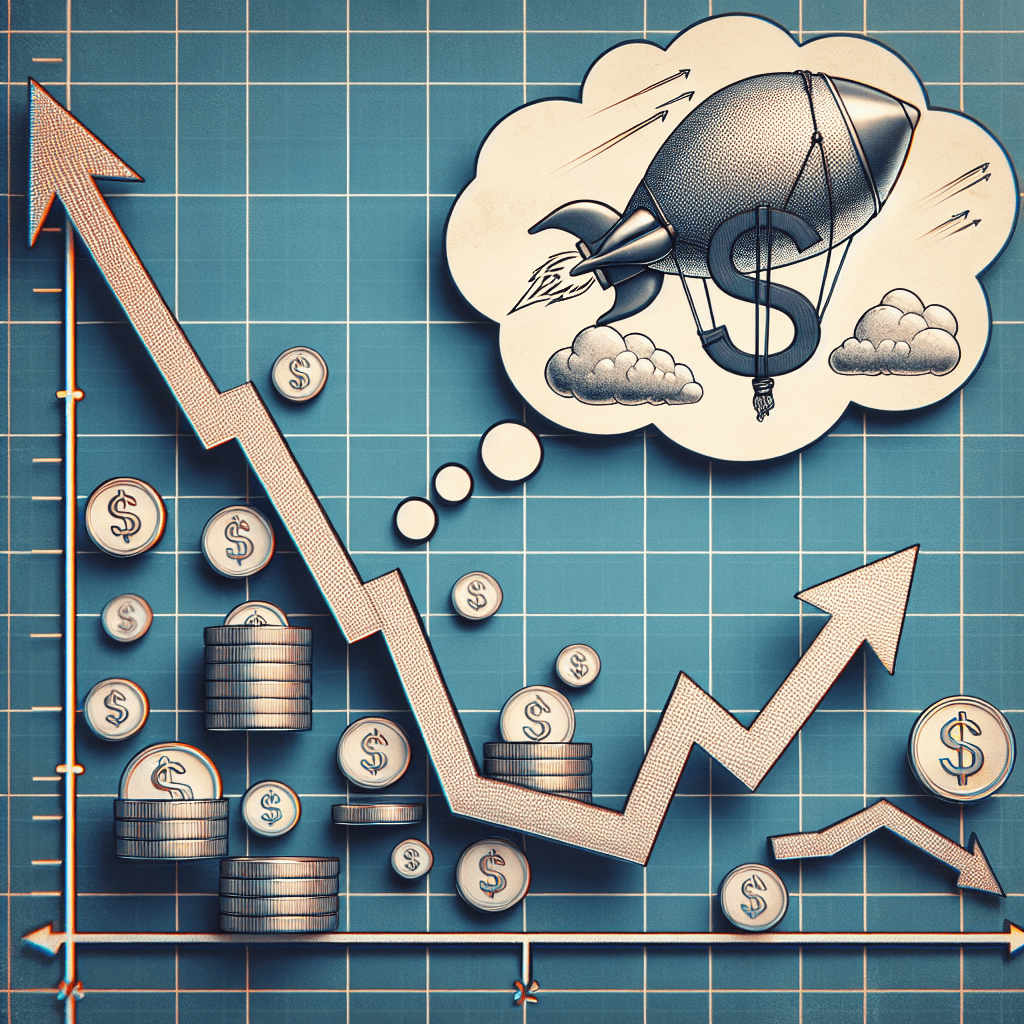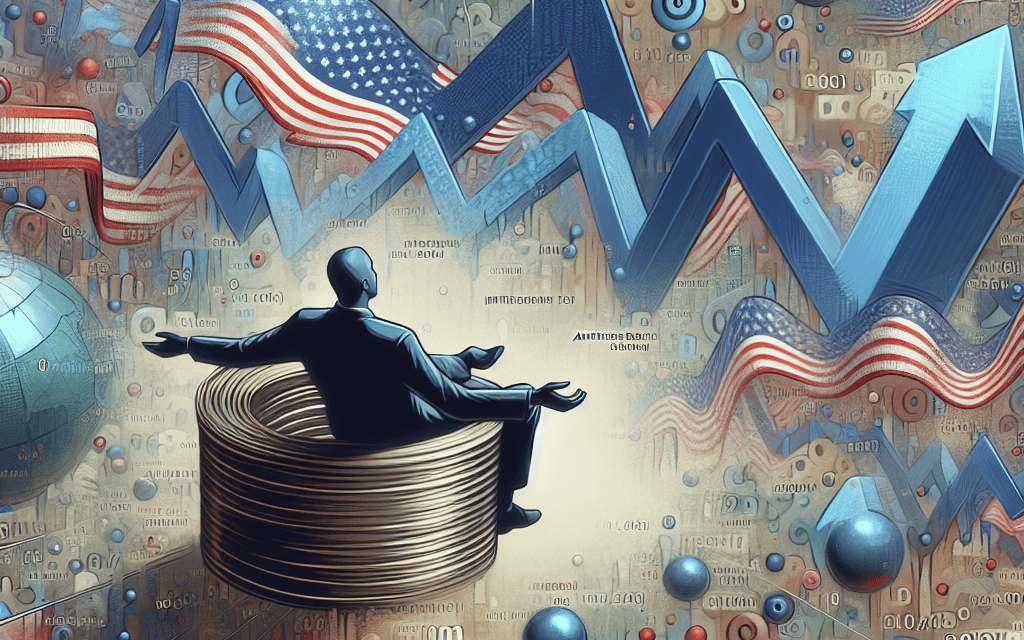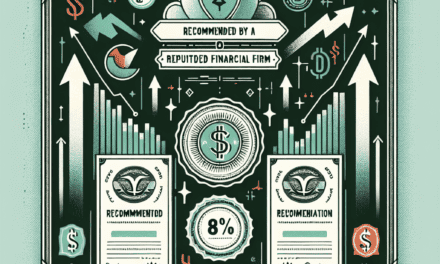“US Bonds Tumble: Navigating Market Waves in the Wake of Inflation Speculation”
Introduction
In a dramatic turn of events, U.S. bonds have experienced their most significant decline since the onset of the COVID-19 pandemic, driven by heightened market volatility and investor anxiety. This downturn is largely attributed to recent speculations by former President Donald Trump regarding potential inflationary pressures on the economy. As investors grapple with the implications of these statements, the bond market has reacted with a sharp sell-off, reflecting broader concerns about the future trajectory of interest rates and economic stability. This development underscores the sensitivity of financial markets to political discourse and economic forecasts, highlighting the intricate interplay between policy speculation and market dynamics.
Impact Of Inflation Speculation On US Bonds Market
The US bonds market has recently experienced its most significant drop since the onset of the COVID-19 pandemic, a development largely attributed to former President Donald Trump’s comments on inflation. This unexpected downturn has sent ripples through the financial sector, raising concerns among investors and policymakers alike. To understand the implications of this decline, it is essential to examine the factors contributing to the market’s volatility and the broader economic context in which these events are unfolding.
In recent weeks, Trump’s remarks have reignited fears of rising inflation, a concern that has been simmering beneath the surface of the US economy. His statements, suggesting that inflation could spiral out of control, have added fuel to an already tense economic environment. As a result, investors have become increasingly wary of the potential for higher interest rates, which could erode the value of existing bonds. This apprehension has led to a sell-off in the bond market, driving prices down and yields up.
The relationship between inflation expectations and bond prices is a well-established economic principle. When investors anticipate higher inflation, they demand higher yields to compensate for the decreased purchasing power of future interest payments. Consequently, bond prices fall as yields rise. This inverse relationship has been a key driver of the recent market dynamics, as Trump’s comments have heightened inflationary fears.
Moreover, the current economic landscape is characterized by a complex interplay of factors that exacerbate these concerns. The US economy is still recovering from the pandemic-induced recession, with supply chain disruptions and labor shortages contributing to upward pressure on prices. Additionally, the Federal Reserve’s monetary policy stance has been a focal point for market participants. While the Fed has signaled its intention to maintain accommodative policies to support economic recovery, any indication of a shift towards tightening could further unsettle the bond market.
In this context, Trump’s inflation speculation has acted as a catalyst, amplifying existing anxieties and prompting a reassessment of risk among investors. The resulting market volatility underscores the sensitivity of financial markets to political rhetoric and the importance of clear communication from policymakers. As investors navigate this uncertain environment, they must weigh the potential for inflation against the broader economic recovery and the Fed’s policy trajectory.
Furthermore, the implications of this bond market decline extend beyond the immediate financial sector. Rising yields can have a cascading effect on the economy, influencing borrowing costs for businesses and consumers. Higher interest rates can dampen investment and spending, potentially slowing economic growth. This dynamic highlights the interconnectedness of financial markets and the real economy, as well as the challenges faced by policymakers in balancing growth and inflation.
In conclusion, the recent drop in the US bonds market, driven by inflation speculation and Trump’s comments, reflects the complex and multifaceted nature of the current economic environment. As investors and policymakers grapple with these challenges, the need for careful analysis and strategic decision-making becomes increasingly apparent. The path forward will require a nuanced understanding of the interplay between inflation expectations, monetary policy, and economic recovery, as well as a recognition of the broader implications for financial stability and growth.
Analyzing The Largest Drop In US Bonds Since The Pandemic
The recent decline in US bonds marks the most significant drop since the onset of the COVID-19 pandemic, a development that has captured the attention of investors and analysts alike. This downturn is largely attributed to former President Donald Trump’s recent comments speculating on potential inflationary pressures, which have reignited concerns about the stability of the US economy. As market participants grapple with these developments, it is crucial to understand the underlying factors contributing to this bond market volatility and the broader implications for the financial landscape.
To begin with, the bond market is highly sensitive to changes in inflation expectations. Bonds, particularly those with fixed interest rates, tend to lose value when inflation rises because the purchasing power of their future cash flows diminishes. Trump’s remarks have stirred fears that inflation could accelerate, prompting investors to reassess their portfolios and shift away from bonds. This reaction is not entirely unexpected, as the former president’s influence on economic discourse remains significant, and his statements often carry weight in financial circles.
Moreover, the current economic environment is already fraught with uncertainty. The Federal Reserve has been navigating a delicate balance between fostering economic growth and controlling inflation. While the central bank has signaled its commitment to maintaining price stability, any indication of rising inflation can lead to heightened market volatility. Trump’s comments have added fuel to this fire, causing investors to question whether the Fed’s current policies will be sufficient to keep inflation in check.
In addition to inflation concerns, the bond market is also reacting to broader economic indicators. Recent data on employment, consumer spending, and manufacturing output have painted a mixed picture of the US economy. While some sectors have shown signs of recovery, others continue to struggle, leading to an uneven economic landscape. This inconsistency has made it challenging for investors to predict future interest rate movements, further contributing to bond market fluctuations.
Furthermore, geopolitical tensions and global economic trends are also playing a role in shaping investor sentiment. The ongoing trade disputes and diplomatic challenges have created an environment of uncertainty, prompting investors to seek safer assets. However, with bonds now perceived as riskier due to inflation fears, there is a growing demand for alternative investment options, such as equities or commodities, which offer potentially higher returns in an inflationary environment.
As the bond market experiences this significant drop, it is essential for investors to remain vigilant and consider the long-term implications of their investment strategies. Diversification remains a key principle, as it can help mitigate risks associated with market volatility. Additionally, staying informed about economic developments and central bank policies can provide valuable insights into potential market shifts.
In conclusion, the largest drop in US bonds since the pandemic underscores the complex interplay of factors influencing the financial markets. Trump’s inflation speculation has undoubtedly contributed to this volatility, but it is only one piece of a larger puzzle. As investors navigate this challenging landscape, they must weigh the risks and opportunities presented by current economic conditions. By maintaining a balanced perspective and adapting to changing circumstances, investors can better position themselves to weather the uncertainties that lie ahead.
Trump’s Influence On Inflation And Its Effect On Bonds
In recent months, the U.S. bond market has experienced its most significant decline since the onset of the COVID-19 pandemic, a development that has been closely linked to former President Donald Trump’s comments on inflation. Trump’s remarks have reignited concerns about inflationary pressures, which have, in turn, influenced investor behavior and market dynamics. As the bond market reacts to these speculations, it is crucial to understand the interplay between political rhetoric, economic expectations, and financial instruments.
To begin with, the bond market is highly sensitive to inflation expectations because inflation erodes the purchasing power of future cash flows from bonds. When investors anticipate higher inflation, they often demand higher yields to compensate for the expected decrease in purchasing power. Consequently, bond prices fall as yields rise. Trump’s recent comments have fueled fears of rising inflation, prompting investors to reassess their portfolios and adjust their strategies accordingly. This shift in sentiment has contributed to the notable drop in bond prices, marking the largest decline since the pandemic’s early days.
Moreover, Trump’s influence on inflation expectations cannot be viewed in isolation. His statements come at a time when the U.S. economy is already grappling with various inflationary pressures. Supply chain disruptions, labor shortages, and increased consumer demand have all contributed to rising prices across multiple sectors. The Federal Reserve has been closely monitoring these developments, with policymakers debating the appropriate timing and magnitude of interest rate adjustments to curb inflation without stifling economic growth. In this context, Trump’s comments have added another layer of complexity to an already challenging economic landscape.
Furthermore, the bond market’s reaction to Trump’s inflation speculation underscores the broader impact of political figures on financial markets. Investors often look to political leaders for cues about future economic policies and conditions. As a former president with a significant following, Trump’s statements carry weight and can sway market sentiment. This phenomenon highlights the interconnectedness of politics and economics, where rhetoric can have tangible effects on market behavior and investor confidence.
In addition to the immediate impact on bond prices, the current situation raises questions about the long-term implications for the U.S. economy. If inflation expectations continue to rise, the Federal Reserve may be compelled to accelerate its plans for tightening monetary policy. This could involve raising interest rates sooner than anticipated, which would have far-reaching consequences for borrowing costs, consumer spending, and overall economic growth. The bond market’s response to Trump’s comments serves as a reminder of the delicate balance that policymakers must strike in managing inflation while supporting economic recovery.
In conclusion, the recent decline in U.S. bond prices, driven by Trump’s inflation speculation, highlights the intricate relationship between political discourse and financial markets. As investors navigate this complex environment, they must remain vigilant and adaptable, considering both economic fundamentals and the potential influence of political rhetoric. The situation also underscores the importance of clear communication from policymakers, as they seek to guide the economy through a period of heightened uncertainty and volatility. Ultimately, the bond market’s reaction serves as a barometer of broader economic sentiment, reflecting the challenges and opportunities that lie ahead in an ever-evolving landscape.
Understanding The Relationship Between Inflation And Bond Prices

The recent significant drop in US bond prices, the largest since the onset of the pandemic, has sparked widespread concern and speculation, particularly in light of former President Donald Trump’s comments on inflation. Understanding the intricate relationship between inflation and bond prices is crucial to comprehending the current financial landscape. Bonds, essentially loans made by investors to borrowers, typically governments or corporations, are sensitive to changes in interest rates and inflation. When inflation rises, the purchasing power of the fixed interest payments from bonds diminishes, leading to a decrease in their attractiveness to investors. Consequently, bond prices tend to fall as inflation expectations increase.
The recent decline in bond prices can be attributed to heightened inflationary pressures, which have been exacerbated by Trump’s remarks. His comments have fueled speculation that inflation may rise more sharply than previously anticipated, prompting investors to reassess their portfolios. As inflation expectations rise, investors demand higher yields to compensate for the anticipated erosion of purchasing power, resulting in a sell-off of existing bonds with lower yields. This sell-off drives bond prices down, as seen in the current market scenario.
Moreover, the Federal Reserve’s monetary policy plays a pivotal role in shaping inflation expectations and, by extension, bond prices. The central bank’s decisions regarding interest rates are closely monitored by investors, as they signal the Fed’s stance on inflation control. In periods of rising inflation, the Fed may opt to increase interest rates to curb inflationary pressures. However, higher interest rates make existing bonds with lower yields less attractive, further contributing to the decline in bond prices. Thus, the interplay between the Fed’s policy decisions and market expectations is a critical factor influencing bond market dynamics.
In addition to domestic factors, global economic conditions also impact US bond prices. Inflationary trends in major economies, such as the European Union and China, can have ripple effects on the US market. For instance, if inflation rises in these regions, it may lead to increased demand for US goods, thereby exerting upward pressure on US inflation. This interconnectedness underscores the importance of a comprehensive understanding of global economic trends when analyzing bond market movements.
Furthermore, investor sentiment and market psychology cannot be overlooked when examining the relationship between inflation and bond prices. Market participants often react to news and events based on their perceptions and expectations, which can sometimes lead to exaggerated market movements. Trump’s comments on inflation, for instance, may have amplified concerns among investors, leading to a more pronounced reaction in the bond market. This highlights the role of communication and information dissemination in shaping market dynamics.
In conclusion, the recent drop in US bond prices, driven by inflation speculation and former President Trump’s remarks, underscores the complex relationship between inflation and bond prices. A multitude of factors, including inflation expectations, Federal Reserve policy, global economic conditions, and investor sentiment, interact to influence bond market movements. Understanding these dynamics is essential for investors and policymakers alike, as they navigate the challenges posed by inflationary pressures and their impact on financial markets. As the situation continues to evolve, close monitoring of economic indicators and policy decisions will be crucial in anticipating future trends in the bond market.
Historical Context: US Bonds Performance During Economic Uncertainty
The performance of US bonds has long been a barometer of economic stability, reflecting the nation’s fiscal health and investor sentiment. Historically, during periods of economic uncertainty, US bonds have served as a safe haven for investors seeking refuge from volatile markets. This trend was particularly evident during the financial crisis of 2008, when investors flocked to the relative safety of government securities, driving bond prices up and yields down. Similarly, the onset of the COVID-19 pandemic in early 2020 saw a dramatic surge in demand for US bonds, as global markets grappled with unprecedented disruptions and uncertainty.
However, the recent developments in the bond market have deviated from this historical pattern. In a surprising turn of events, US bonds have experienced their largest drop since the pandemic, a decline that has been closely linked to former President Donald Trump’s recent comments on inflation. Trump’s speculation about rising inflation has reignited concerns among investors, prompting a reevaluation of the economic landscape and the potential implications for monetary policy. This shift in sentiment has led to a sell-off in the bond market, as investors anticipate higher interest rates in response to inflationary pressures.
To understand the current situation, it is essential to consider the broader economic context. Inflation has been a topic of considerable debate among economists and policymakers, with some arguing that the recent uptick is transitory, driven by supply chain disruptions and pent-up consumer demand. Others, however, warn of more persistent inflationary pressures, fueled by expansive fiscal policies and accommodative monetary measures. Trump’s comments have added fuel to this debate, amplifying concerns that inflation may be more entrenched than previously thought.
The impact of these inflationary fears on the bond market is multifaceted. As investors brace for the possibility of higher interest rates, the appeal of existing bonds with lower yields diminishes, leading to a decline in bond prices. This inverse relationship between bond prices and yields is a fundamental principle of fixed-income markets, and it underscores the sensitivity of bonds to changes in interest rate expectations. Moreover, the prospect of rising inflation erodes the real returns on bonds, further dampening investor appetite for these securities.
In addition to inflation concerns, the bond market is also navigating other challenges, including geopolitical tensions and shifts in global economic dynamics. The interplay of these factors creates a complex environment for bond investors, who must weigh the risks and opportunities in a rapidly evolving landscape. Despite these challenges, it is important to recognize that the bond market’s recent decline is not without precedent. Throughout history, US bonds have weathered periods of volatility and uncertainty, often emerging as a resilient asset class in the face of adversity.
In conclusion, the recent drop in US bonds, driven by inflation speculation and broader economic uncertainties, highlights the intricate relationship between market dynamics and investor sentiment. While the current environment presents challenges, it also underscores the importance of historical context in understanding the performance of US bonds during times of economic uncertainty. As investors navigate this complex landscape, the lessons of the past may offer valuable insights into the future trajectory of the bond market.
Strategies For Investors Amid Volatile Bond Markets
In recent months, the US bond market has experienced its most significant drop since the onset of the COVID-19 pandemic, a development that has left investors grappling with uncertainty. This decline has been exacerbated by former President Donald Trump’s recent comments speculating about potential inflationary pressures. As investors navigate this volatile landscape, it is crucial to adopt strategies that can mitigate risks while capitalizing on potential opportunities.
To begin with, understanding the factors contributing to the current bond market volatility is essential. The bond market is highly sensitive to changes in interest rates and inflation expectations. Trump’s remarks have reignited concerns about inflation, which, if realized, could lead to higher interest rates. Higher rates typically result in lower bond prices, as the fixed interest payments from existing bonds become less attractive compared to new issues. Consequently, investors are now faced with the challenge of reassessing their portfolios in light of these potential shifts.
In this context, diversification emerges as a key strategy for investors. By spreading investments across various asset classes, including equities, commodities, and real estate, investors can reduce their exposure to bond market fluctuations. Diversification not only helps in managing risk but also provides opportunities for growth in other sectors that may benefit from inflationary trends. For instance, commodities like gold and silver often perform well during periods of inflation, serving as a hedge against the eroding purchasing power of fixed-income investments.
Moreover, investors should consider adjusting the duration of their bond holdings. Duration measures a bond’s sensitivity to interest rate changes; longer-duration bonds are more susceptible to price declines when rates rise. By shifting towards shorter-duration bonds, investors can reduce their exposure to interest rate risk. Additionally, floating-rate bonds, which have interest payments that adjust with market rates, can offer protection in a rising rate environment.
Another strategy involves focusing on credit quality. In uncertain times, high-quality bonds, such as those issued by the US government or blue-chip corporations, tend to be more resilient. These bonds are less likely to default and can provide a stable income stream even amid market turbulence. Conversely, lower-quality bonds, while offering higher yields, carry greater risk and may not be suitable for risk-averse investors during periods of heightened volatility.
Furthermore, active management can play a vital role in navigating volatile bond markets. Unlike passive strategies that track a specific index, active management allows for more flexibility in responding to market changes. Skilled managers can adjust portfolios dynamically, taking advantage of market inefficiencies and identifying opportunities that may arise from shifting economic conditions.
In addition to these strategies, maintaining a long-term perspective is crucial. While short-term market fluctuations can be unsettling, history has shown that markets tend to recover over time. By focusing on long-term goals and maintaining a disciplined investment approach, investors can weather the storm and potentially benefit from future market recoveries.
In conclusion, the recent drop in US bonds, fueled by inflation speculation, underscores the importance of strategic planning in volatile markets. By diversifying portfolios, adjusting bond durations, prioritizing credit quality, and considering active management, investors can better position themselves to navigate the challenges and opportunities that lie ahead. As always, consulting with financial advisors to tailor strategies to individual risk tolerances and objectives is advisable, ensuring that investment decisions align with long-term financial goals.
Future Outlook: US Bonds In An Inflationary Environment
The recent turbulence in the US bond market, marked by the largest drop since the onset of the pandemic, has sparked widespread concern among investors and policymakers alike. This decline has been exacerbated by former President Donald Trump’s speculative comments on inflation, which have added a layer of uncertainty to an already volatile economic landscape. As we navigate this complex environment, it is crucial to understand the factors contributing to these developments and their potential implications for the future of US bonds.
To begin with, the bond market is highly sensitive to changes in inflation expectations. When investors anticipate higher inflation, they often demand higher yields to compensate for the eroding purchasing power of future interest payments. This dynamic has been at play in recent months, as inflationary pressures have mounted due to a combination of supply chain disruptions, labor shortages, and robust consumer demand. Trump’s remarks, suggesting that inflation could spiral out of control, have only intensified these concerns, prompting a sell-off in bonds and driving yields higher.
Moreover, the Federal Reserve’s monetary policy stance plays a pivotal role in shaping the bond market’s trajectory. The central bank has signaled its intention to gradually taper its asset purchases, a move that is widely interpreted as a precursor to eventual interest rate hikes. This anticipated tightening of monetary policy has further fueled investor anxiety, as higher interest rates typically lead to lower bond prices. Consequently, the interplay between inflation expectations and the Fed’s policy decisions will be a key determinant of bond market performance in the coming months.
In addition to these domestic factors, global economic conditions also exert a significant influence on US bonds. The interconnectedness of financial markets means that developments abroad can have ripple effects at home. For instance, the ongoing economic recovery in Europe and Asia has led to increased demand for commodities, contributing to upward pressure on prices. Similarly, geopolitical tensions and trade uncertainties can impact investor sentiment, leading to fluctuations in bond yields. Therefore, a comprehensive assessment of the bond market must take into account both domestic and international dynamics.
Looking ahead, the future outlook for US bonds in an inflationary environment remains uncertain. On one hand, if inflation proves to be transitory, as some economists suggest, the recent sell-off may be an overreaction, and bond prices could stabilize. On the other hand, if inflation persists at elevated levels, the Fed may be compelled to adopt a more aggressive tightening stance, which could further depress bond prices. In this context, investors will need to carefully monitor economic indicators and central bank communications to gauge the likely path of inflation and interest rates.
Furthermore, diversification strategies may become increasingly important for bond investors seeking to mitigate risk in this uncertain environment. By spreading investments across different asset classes and geographies, investors can potentially reduce their exposure to inflationary pressures and interest rate volatility. Additionally, exploring alternative fixed-income instruments, such as inflation-protected securities, may offer a hedge against rising prices.
In conclusion, the recent drop in US bonds underscores the challenges posed by an inflationary environment and the complexities of navigating a rapidly evolving economic landscape. As market participants grapple with these uncertainties, a nuanced understanding of the interplay between inflation expectations, monetary policy, and global economic conditions will be essential for making informed investment decisions. Ultimately, the future of US bonds will hinge on the delicate balance between these factors and the ability of policymakers to effectively manage inflationary pressures.
Q&A
1. **What caused the largest drop in US bonds since the pandemic?**
The largest drop in US bonds since the pandemic was primarily caused by market reactions to inflation speculation, which was influenced by comments from former President Donald Trump.
2. **How did Trump’s comments influence inflation speculation?**
Trump’s comments likely heightened concerns about potential inflationary pressures, leading investors to anticipate higher interest rates, which negatively impacted bond prices.
3. **What is the relationship between inflation and bond prices?**
Inflation erodes the purchasing power of future cash flows from bonds, leading to higher interest rates and lower bond prices as investors demand higher yields to compensate for the increased inflation risk.
4. **How do rising interest rates affect bond prices?**
Rising interest rates cause existing bond prices to fall because new bonds are issued with higher yields, making the older, lower-yielding bonds less attractive to investors.
5. **What are the potential economic implications of a significant drop in bond prices?**
A significant drop in bond prices can lead to increased borrowing costs for governments and corporations, potentially slowing economic growth and affecting financial markets.
6. **How might investors react to a drop in bond prices?**
Investors might shift their portfolios towards equities or other assets perceived as inflation hedges, or they might seek bonds with shorter durations to mitigate interest rate risk.
7. **What measures can the Federal Reserve take in response to inflation concerns?**
The Federal Reserve can raise interest rates or reduce its bond-buying programs to combat inflation, aiming to stabilize prices and maintain economic growth.
Conclusion
The recent significant drop in US bonds, marking the largest decline since the pandemic, can be attributed to heightened market volatility and investor uncertainty, exacerbated by former President Trump’s comments on inflation. His speculation has likely intensified concerns about future economic stability and inflationary pressures, prompting investors to reassess their bond holdings. This situation underscores the sensitivity of financial markets to political rhetoric and economic forecasts, highlighting the need for careful navigation by policymakers and investors to maintain market confidence and economic resilience.





